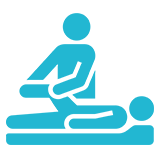
With outpatient laser spine surgery, you can be back to your regular activities in no time at all.
Even with surgery often being a last resort for most patients, it’s comforting to know that many spine conditions can be treated with less invasive procedures. Laser spine surgery combines the strategic use of lasers with minimally invasive techniques to treat a wide range of spine conditions. Laser spine surgery is also appealing since many procedures can be performed the same day without the need for an overnight stay.
Outpatient laser spine surgery may be an effective option for spinal pain, including:
- Cervical spine (neck) pain
- Disc-related pain
- Upper- and middle-back (thoracic spine) pain
- Radiculopathy (nerve pain that produces symptoms felt away from the source)
- Neurogenic claudication (nerve compression related to spinal stenosis)
CONTACT US TODAY

Are You a Candidate?
If you’ve tried other methods for back pain relief, such as over-the-counter medications, physical therapy, and injections–but haven’t found relief–then you might be a candidate for laser spine surgery in order to experience pain relief.The surgery may be an option for patients dealing with herniated discs, spinal stenosis, and more.

Latest Advances
The strategic use of lasers to make incisions needed for surgery mean that there is less recovery time and decreased risk of infection post-surgery. With this new advancement in spine surgery, more patients are finding that surgery is a possibility for them.

Outpatient Approach
By performing laser spine surgery in an outpatient setting, patients are able to go home the same day and recover in the comfort of their own homes. This approach is less expensive, more convenient, and extremely safe.

Going Forward
Often, patients find that laser spine surgery provides the pain relief needed to continue making strides in strength and flexibility. With relief from surgery, other approaches like physical therapy become easier and more effective.
Many types of spine-related pain can be treated with outpatient laser spine surgery. Lower back pain is one of the most common types of back pain that can sometimes become enough of a distraction to require a doctor’s visit and an eventual referral to a specialist. The muscles, tendons, and ligaments in the lower back often act as shock absorbers during your normal movements. This is also where pressure is often felt as you bend, twist, and sit. Possible sources of low back pain include:
- Bulging or herniated discs
- Spinal stenosis (abnormal narrowing of the spine)
- Spondylolisthesis (lower back disc slips forward over the one below it)
- Lumbar vertebral fractures
Most instances of lower back pain will go away with a little rest, over-the-counter medications, and the application of heat or ice. However, there are times when occasional discomfort turns into chronic pain, defined as pain lasting 3-6 months or more. If conservative treatments aren’t effective and a clear source of pain can be identified with image testing, you may be a candidate for laser spine surgery.


Minimally Invasive Decompression Surgery
There are two main types of laser spine surgery that may provide much-appreciated relief — decompression and stabilization. For most patients with back or neck pain related to a compressed nerve, decompression surgery provides relief. The purpose of decompression is take pressure off of pinched or compressed nerve roots. Disc herniation, spinal stenosis, and bone spurs are among the most common sources of nerve-related back or neck pain.
With a minimally invasive discectomy performed for decompression purposes, only the disc material that’s protruding or pressing on a nerve root is removed. Stability of the spine is not affected. This type of discectomy often benefits patients with disc problems related to degenerative disc disease (age-related disc damage) and sciatica that may be contributing to leg pain and difficulty with mobility.
Nerves near the spine may also be decompressed with a minimally invasive foraminotomy. It’s a procedure done to relieve nerve pressure from foraminal stenosis, the narrowing of a passageway located on both sides of the vertebrae (foraminal canal). If a compressed nerve is affecting the back of the spinal cord, a minimally invasive laminotomy may be more appropriate. During the procedure, part of a small bone (lamina) is removed to free a compressed nerve.
Laser Spine Surgery for Stabilization
The spine sometimes becomes unstable following decompression surgery, usually after a damaged disc has to be fully removed. If this is the case, stabilization surgery is usually necessary to restore the integrity of the spine. Fortunately, there are minimally invasive stabilization surgery options that can be performed as outpatient procedures. With stabilization procedures, the damaged disc that was removed with a discectomy is replaced with an artificial disc. With some procedures, a spacer is inserted to maintain spinal height.
Patients with a diseased or damaged cervical disc that’s causing chronic neck pain and/or radiating arm and shoulder pain may benefit from a minimally invasive cervical disc replacement. An anterior cervical discectomy and fusion (ACDF) is a variation on this procedure that’s performed from the front of the neck with the guidance of a special X-ray. For patients with lower back pain related to damaged disc, a minimally invasive transforaminal lumbar interbody fusion (TLIF) may provide relief while also stabilizing the spine. The procedure involves the insertion of a spacer and bone graft into the disc.
Specific recovery times with laser spine surgery will vary, although recovery from same-day, outpatient procedures is typically shorter than what’s experienced with more invasive operations. Patients also benefit from smaller incisions, fewer surgical risks, and no disruption to nearby muscles. Some procedures only require a small bandage. It’s also common to see patients walking with little or no discomfort shortly after surgery is completed.

